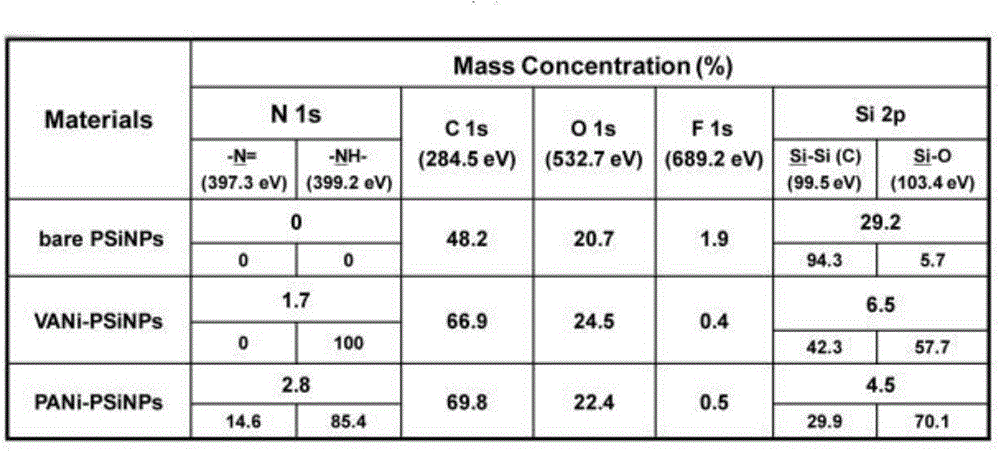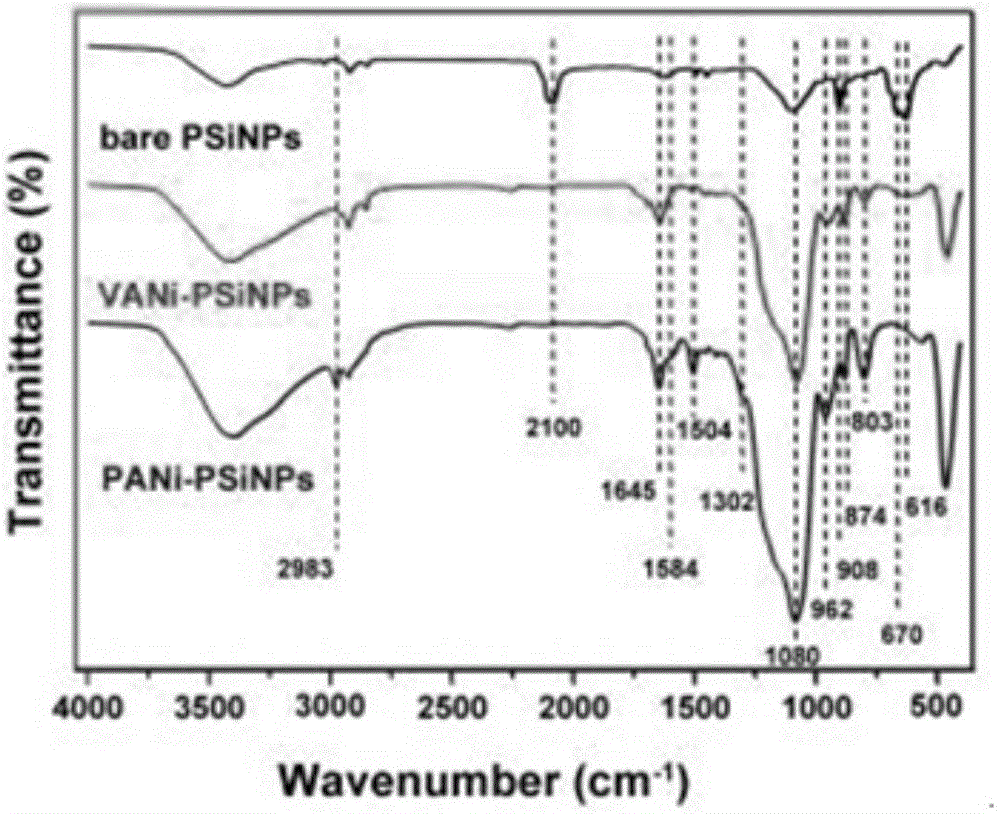Degradable polyaniline/porous silicon nanocomposite as well as preparation method and application thereof
A technology of nanocomposite materials and porous silicon, which can be applied in medical preparations with non-active ingredients, medical preparations containing active ingredients, wave energy or particle radiation treatment materials, etc., and can solve the problem of hindering combination therapy and low anticancer drug loading ability, poor water solubility and other issues, to achieve stable photothermal ability, obvious synergistic therapeutic effect of chemotherapy and hyperthermia combination, and good water solubility
- Summary
- Abstract
- Description
- Claims
- Application Information
AI Technical Summary
Problems solved by technology
Method used
Image
Examples
Embodiment 1
[0035] Material preparation: Cut the silicon wafer into 2cm×2cm squares, put it in a solution of concentrated sulfuric acid (98%): hydrogen peroxide = 3:1 (volume ratio), and soak for 30 minutes under heating at 80°C to remove the surface Organic contaminants are then rinsed several times with large amounts of deionized water. Mix 40% hydrofluoric acid and deionized water in a plastic beaker at a volume ratio of 1:1, then put the silicon wafers rinsed with deionized water into the mixture, rinse each wafer for 30 seconds to remove the surface 的oxide layer.
[0036] The silicon wafer is the anode, the platinum wire is the cathode, and the etching solution is a mixed solution of hydrofluoric acid and absolute ethanol in a volume ratio of 3:1. The substrate is a pretreated P-type silicon wafer, with a layer of aluminum film on the back to form a good ohmic contact. Under the state of DC voltage regulation, the current density is 100mA / cm 2 , The etching time is 15 minutes to etch th...
Embodiment 2
[0042] Example 2 Cell Application
[0043] The MTT experiment was used to evaluate the viability of 4T1 cells. The cells were incubated with DOX, PANi-PSiNPs, and DOX@PANi-PSiNPs, respectively, and then irradiated with laser for 20 minutes (for a control experiment, the material was illuminated and not illuminated). Incubate for different times (2, 4, 10 or 20 hours). Such as Image 6 After the incubation, DOX@PANi-PSiNPs combined with laser showed the highest cytotoxicity compared with other groups. The results showed that compared with the control group, under the same conditions, the cell survival rate of only chemotherapy was 37.1% , The cell survival rate of photothermal therapy alone was 62.2%, while the cell survival rate of chemotherapy combined with photothermal therapy was 23.1%.
Embodiment 3
[0044] Example 3 In vivo application
[0045] Will 10 6 One mouse breast cancer cell (4T1) was injected into the outer right leg of Balb / C mouse, when the tumor size reached 50-70mm 3 Intratumoral injection materials: (1) phosphate buffered saline (PBS) + NIR (near infrared laser) (control), (2) doxorubicin (DOX) + NIR, (3) PANi-PSiNPs + NIR, ( 4) DOX@PANi-PSiNPs, (5) DOX@PANi-PSiNPs+NIR, the injection dose is 1mg / kg DOX, 10mg / kg PANi-PSiNPs or 10mg / kg DOX@PANi-PSiNPs, NIR laser power is 1.4W / cm 2 , The irradiation time is 10 minutes, and the temperature change of the mouse tumor is detected with a thermal imaging camera. Figure 7 After 10 minutes of NIR laser irradiation, the temperature of the tumor area injected by PANi-PSiNPs and DOX@PANi-PSiNPs increased to about 45°C, while the temperature of the tumor area in the other groups was about 30°C. The results showed that PANi-PSiNPs were injected in vivo And DOX@PANi-PSiNPs can still show excellent photothermal effect. In the...
PUM
 Login to View More
Login to View More Abstract
Description
Claims
Application Information
 Login to View More
Login to View More - R&D
- Intellectual Property
- Life Sciences
- Materials
- Tech Scout
- Unparalleled Data Quality
- Higher Quality Content
- 60% Fewer Hallucinations
Browse by: Latest US Patents, China's latest patents, Technical Efficacy Thesaurus, Application Domain, Technology Topic, Popular Technical Reports.
© 2025 PatSnap. All rights reserved.Legal|Privacy policy|Modern Slavery Act Transparency Statement|Sitemap|About US| Contact US: help@patsnap.com



